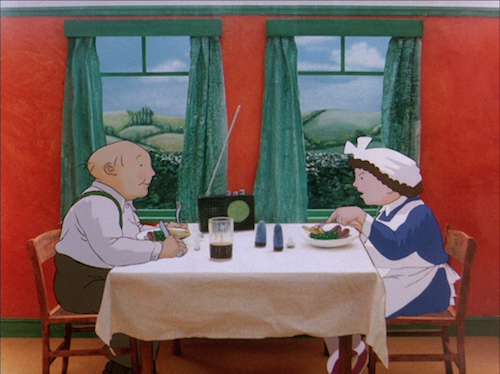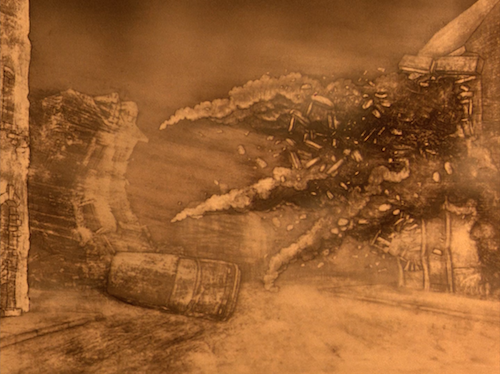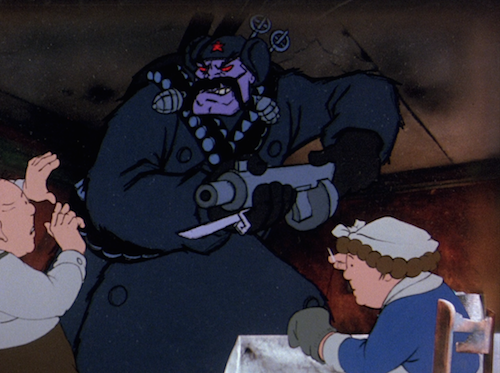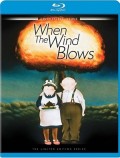| Reviews & Columns |
|
Reviews DVD TV on DVD Blu-ray 4K UHD International DVDs In Theaters Reviews by Studio Video Games Features Collector Series DVDs Easter Egg Database Interviews DVD Talk Radio Feature Articles Columns Anime Talk DVD Savant Horror DVDs The M.O.D. Squad Art House HD Talk Silent DVD
|
DVD Talk Forum |
|
|
| Resources |
|
DVD Price Search Customer Service #'s RCE Info Links |
|
Columns
|
|
|
When the Wind Blows
The Movie:

When the Wind Blows is a significantly different film from director Jimmy T. Murakami's first animation project based on the work of author-illustrator Raymond Briggs, which was the holiday perennial from 1982, The Snowman. This time, rather than positing a whimsical notion like, "What if a snowman came to life and flew?," this 1987 film from Murakami and Briggs wonders, "What if they drop a nuke on London?"
With its lead characters drawn in a soft, cuddly style similar to The Snowman, When the Wind Blows is a sneakily startling, darkly humorous tragedy about an old retired couple living out in the countryside, forced to deal with nuclear armageddon. The action unfolds almost entirely within the modest home of Jim and Hilda Bloggs, a naive but sweet working-class pair (voiced somewhat controversially -- but brilliantly -- by a Sir and a Dame, John Mills and Peggy Ashcroft). In fact, if this film had been attempted as an entirely live-action production, it might have the atmosphere of a filmed play. I use the modifier "entirely" there, because, in an attempt to give the visuals more definition, Murakami frequently uses real model sets for the rooms that his two-dimensional animated characters inhabit. It gives the eye something unusual to appreciate, and it arguably makes the setting more believable than if the entire film was flat 2D animation.
While When the Wind Blows is about the realities of a nuclear attack, it largely takes the tone of a domestic sitcom. The first thirty minutes -- more than a third of the film -- set us up in a world that we could never imagine being disrupted by nuclear war. Jim hears on the radio that conflict with the Russians might escalate to war within three days, so he prepares. He follows -- to the letter -- a government pamphlet on precautions to take against a nuclear bomb, by painting the windows white to deflect the heat of the bomb blast, filling empty glass bottles with drinking water, gathering tinned food (and condiments!), and building a tiny shelter in the middle of the house made from various doors. As he putters around, doing these activities, he and Hilda imagine -- fantasize, really -- what World War III will be like, based on their rose-colored memories of the last one. These characters have no grasp of what's really at stake, but considering their idyllic seclusion, why would they?
Then, suddenly, the bomb is dropped. The impossible has come to be. In a devastating sequence which utilizes a stripped-down pencil-sketch style, we witness the decimation of London and the outlying countryside. In what can only be deemed a fluke, the blast hits Jim and Hilda's house, but does not level it. Most of the furniture -- and those white-painted windows -- are no more, but the shelter made of doors somehow did the trick, and Jim and Hilda survive.
The bitter irony turns out to be that they probably would have been better off if they had not been protected and died in the bombing instead. Encased in their tiny house, Jim and Hilda are unaware of the extent of the nuclear holocaust. Days pass, but they have such faith in (for lack of a better term) The System, that they assume that emergency services will come for them soon, and that the whole incident will be elucidated in the newspaper -- whenever that gets delivered again. In the meanwhile, their food supplies dwindle and they start to suffer strange sick feelings (we in the audience can presume it is radiation poisoning, but Hilda subscribes to the notion that if you can't see anything or feel anything, there must be nothing harmful about). Ever the realist, Jim plots how he will fight off the invading Russian hordes.
Certain viewers are going to have a hard time identifying with Jim and Hilda's willful denial of what's going on around them. Yet, Murakami and Briggs have created full-blooded characters (inspired by the author's parents) and not just satirical caricatures, which makes their plight poignant... even if one wishes they would pull their heads out of their respective behinds.
Just as Powell and Pressburger's The Life and Death of Colonel Blimp argued that the world had changed irrevocably and that World War II would not be like any previous conflict, this film uses comparisons to that war to suggest that the realities of a nuclear war would be far worse than what your average joe might imagine. That the filmmakers situate that theme in the lives of two sweet old fogeys, who assume that everything will be alright if you just keep your head down and get on with it, makes the message all the more heartbreaking.

The Blu-ray
As with most Twilight Time releases, When the Wind Blows comes in a limited edition of 3000 copies and is accompanied by a booklet featuring an essay by Julie Kirgo.
The Video:
Because of its use of different media, the AVC-encoded 1080p 1.33:1 image can be a bit of a mixed bag. Tiny bits of debris can be detected in the image, but frequently these appear to be present in the animation cells themselves. Otherwise, this transfer offers vibrant color reproduction and crisp line detail. It's a typically high-quality transfer from Twilight Time.
The Audio:
The soundtrack of the film is typically pretty sparse, dominated largely by dialogue and isolated sound effects, which are clear and effective. But the DTS-HD MA 2.0 audio really demonstrates its power during the sporadic musical passages by Pink Floyd's Roger Waters, which typically introduce ominous bass-y sounds that effectively turn the viewer's stomach in dread. No subtitles.
Special Features:
- Jimmy Murakami: Non-Alien (HD, 1:17:39) - A 2010 documentary by Sé Merry Doyle that shows Murakami wrestling, near the end of his life, with the four years he spent as a child in a California internment camp for Japanese Americans during World War II. In his adopted home of Ireland, Murakami creates paintings that depict what life in the camp was like, and eventually he makes a pilgrimage to see the internment camp today. This is a truly interesting, powerful portrait.
- Audio commentary by Assistant Editor Joe Fordham and Twilight Time's Nick Redman - An entertaining and informative track full of plenty of production anecdotes from Fordham's two years on the film.
- The Wind and The Bomb (24:19) - An excellent vintage making-of documentary that discusses the origin of the project, then details the unusual nature of the animation process. It includes interviews with director Jimmy Murakami, author Raymond Briggs, and producer John Coates, as well as some of the animators.
- Interview with Raymond Briggs (13:49) - The author and screenwriter describes the inspirations for this story, as well as some of his other books, including The Snowman.
- Isolated Music and Effects Track - Presented in DTS-HD MA 2.0 audio.
Final Thoughts:
While the subject of nuclear war has served as the basis for countless speculative films, few have been as subtle and quietly devastating as When the Wind Blows. Highly Recommended.

Justin Remer is a frequent wearer of beards. His new album of experimental ambient music, Joyce, is available on Bandcamp, Spotify, Apple, and wherever else fine music is enjoyed. He directed a folk-rock documentary called Making Lovers & Dollars, which is now streaming. He also can found be found online reading short stories and rambling about pop music.
|
| Popular Reviews |
| Sponsored Links |
|
|
| Sponsored Links |
|
|
| Release List | Reviews | Shop | Newsletter | Forum | DVD Giveaways | Blu-Ray | Advertise |
|
Copyright 2024 DVDTalk.com All Rights Reserved. Legal Info, Privacy Policy, Terms of Use,
Manage Preferences,
Your Privacy Choices | |||||||











